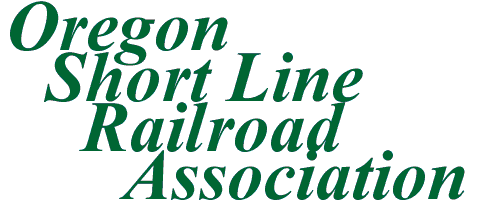Keeping Them Rolling
"Two of the past four winters have wreaked havoc on our railroad with mudslides and washouts that have cost us over $700,000 in repairs alone."
Walt Brickwedel -- Central Oregon & Pacific Railroad, Roseburg
To understand the cost of maintaining Oregon's short
lines, consider a mile of track. In that mile, you'll find about 3,200
railroad ties. It costs around $50 to buy and install each one. Routine
maintenance of existing ties can run $3,500 per mile per year. When you
consider that Oregon short lines cover 1,120 route-miles, it's easy to
see how costs mount up.
"What this means for the 400 miles we
maintain on our system is that we should be spending $1.4 million per year
just to maintain the status quo on the health of our ties."
Robert Melbo -- Former President,
Portland & Western
But ties are only part of the maintenance equation.
Next, count the rail crossings. Oregon's short lines maintain 1,176 public
rail crossings; 424 of those have electronic signals and many have gates.
They must be inspected weekly. Each short line maintains yards and side
track as well.
The Oregon Department of Transportation (ODOT)
recently estimated that Oregon's short lines have immediate rehabilitation
needs of about $32 million. Its Rail Division estimates that about 12
percent of Oregon's short line rail system is in poor condition.
The short lines railroads bear most of the cost of
maintaining their rail lines as well as capital improvements, spending
together about $8 million each year on safety and upkeep. Some federal and
state grant and loan programs are available, but do not come close to
filling the gap.
Oregon's short line operators are doing their part
to keeps the state's lines healthy and safe. That's important for safety
today and for the economy tomorrow.
"Railroad lines tend to be a finite
resource. No one is making more of them. We need to save the ones we have
because we aren't building new ones."
Robert Melbo
|

|

|

|
|
Keeping Jobs
in Oregon
|
Keeping Them Rolling
|
Keeping Timber
Jobs
|
|

|

|

|
|
Easing the Burden
on Oregon's Roads
|
All Around the
Town
|
The Company They
Keep
|
|

|

|

|
|
Facts and Figures
|
A Short Story About
Short Lines
|
Member Connections
|
|

|

|

|
|
Railroad Links
|
Guest Book
|
Oregon Railroad
Map
|
| |
|
|
| |
OSLRA
Home Page |
|
|
| Click
on the image to continue! |
| 